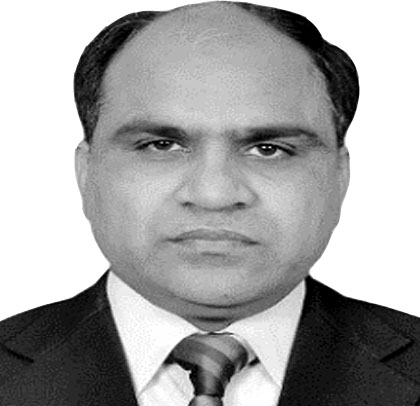Kanwar M Javed Iqbal
ENVIRONMENTAL movements were the driving force behind many concepts so far developed and got significance over period of time with several initiatives and practical steps. The first focused global environmental response was the result of the Sweden’s suggestion to the United Nations Economic and Social Council (ECOSOC) in the year 1968, to have a UN conference on the dimensions of human interactions with the environment which was subsequently supported by ECOSOC vide its resolution 1346. As an outcome, UN Conference on the Human Environment was held in Stockholm in 1972 with focus on “stimulating and providing guidelines for action by national governments and international organizations” facing environmental issues.
The Brundtland Commission Report 1987, titled “Our Common Future”, marked the poverty in the southern and the non-sustainable patterns of production and consumption in the northern part of the world as the key drivers behind the outstanding global environmental problems, and also called for a sustainable development strategy. The Brundtland’s report provided a very good base for the beginning of an important environmental era where the concept of green economy was coined as part of a 1989 report, titled “Blueprint for a Green Economy” (Pearce, Markandya and Barbier, 1989), submitted to the Government of the United Kingdom. This UK government’s report helped in advancing the agenda of Brundtland’s Report with the notion that more sustainable economies require progress on valuing, accounting and incentivising the environment. Later in 1991 and 1994, Blueprint 2: Greening the world economy and Blueprint 3: Measuring Sustainable Development were released by the same authors, and all reports revolved around concept of environmental economics by establishing notion that the economic failures have root-causes for environmental problems. In subsequent development, there were several initiatives for brown and green environment including the clean development mechanism under UNFCCC’s Kyoto Protocol, eco-labelling, environmental fiscal reform, MDGs, clean technologies and cleaner production etc, were noticed worldwide, but propagation of “green economy” was apparently not visible and there was no proper definition for it.
Since the mid of last decade, there were growing concerns of international community regarding the success of MDGs and at the same time there was global economic recession. In 2008, UNEP revived the term green economy, introduced “green stimulus packages”, tried to inspire several governments to implement these significant packages as part of their economic recovery efforts, and also launched decision making support programme in the form of Green Economy Initiative. In March 2010, the UN General Assembly agreed that green economy in the context of sustainable development and poverty eradication would form one of the two specific themes for Rio+20 (resolution 64/236), and UNEP provided definition of green economy in its 2011’s Green Economy Report.
There is no internationally agreed definition of green economy and at least eight separate definitions were identified in recent publications. But, according to UNEP’s definition, green economy is “one that results in improved human well-being and social equity, while significantly reducing environmental risks and ecological scarcities. It is low carbon, resource efficient, and socially inclusive” (UNEP, 2011). On the other hand, Green Economy Coalition provided another widely accepted definition for green economy i.e. “a resilient economy that provides a better quality of life for all within the ecological limits of the planet.” United Nations Conference on Sustainable Development (UNCSD), known as Rio +20”, was held in Rio de Janeiro during June 2012 with a focus on two important agenda items i.e. (1) the development and refinement of the Institutional Framework for Sustainable Development that ultimately produced target oriented time bound Sustainable Development Goals (SDGs) on the foundation of Millennium Development Goals (MDGs), and (2) the advancement of the “Green Economy” concept. During the preparatory phase of Rio+20, several maritime nations questioned the centrality of the Green Economy vis-a-vis the Blue Economy notion towards the role of oceans that account for 72% surface of blue planet with over 95% biosphere part and more than 80% means of transport for global trade, was considered significant for the coastal countries. There were strong arguments to address “Blue Economy” approach more prominently by expanding the Blue aspect of the Green Economy as embodied in the “Green Economy in a Blue World”. Thus, the Blue Economy became international agenda through UN’s Rio+20 and Green Economy for which international efforts to bring into practice coordinated ocean governance mechanisms in order to create success stories.
On the other hand, well before Rio+20, Pauli Gunter gave Blue Economy concept in his Book titled “The Blue Economy: 10 Years, 100 Innovations, 100 Million Jobs” which was basically a report submitted to the Club of Rome in 2009. His concept is not ocean centric. He alludes the blue colour to the view of Earth from space and refers to the environmental sustainability as well as economic well-being, in general terms. His concept revolves around practical, innovative and ambitious projects, significantly impacting world economies and using nature-inspired technologies, while simultaneously responding to human’s basic needs thus may be linked with overall international agenda of SDGs and some conceptual aspects may also be linked with UNEP’s green economy, but have critical aspects in the context of overall sustainability of many products he advocates.
However, Blue Economy under UN’s Rio+20 is an ocean-centric approach and has emerged as a branch of the Green Economy i.e. “a green economy in a blue world” with the objective to provide a better adaptation of the paradigm to coastal and sea-resource based countries and encompasses Green Economy’s principles and main objectives. The application of Blue Economy approach will ensure sustainable growth in a number of key traditional and emerging economic sectors such as: shipping/port activities, fisheries, aquaculture/mari-culture, Coastal tourism, “Blue” energy (wind, wave, tidal, biomass, thermal conversion, and salinity gradients), biotechnological solutions (bio-prospecting) and submarine mining (with potential uses in ICTs and renewable energy) etc.
—The writer is Researcher at National Institute of Maritime Affairs (NIMA), Islamabad.










